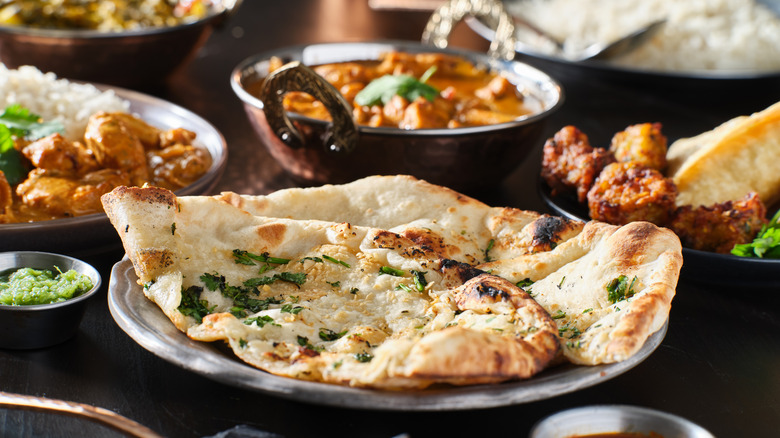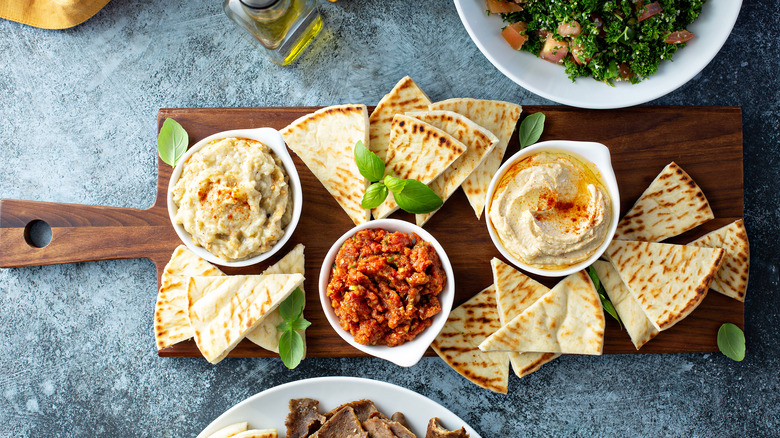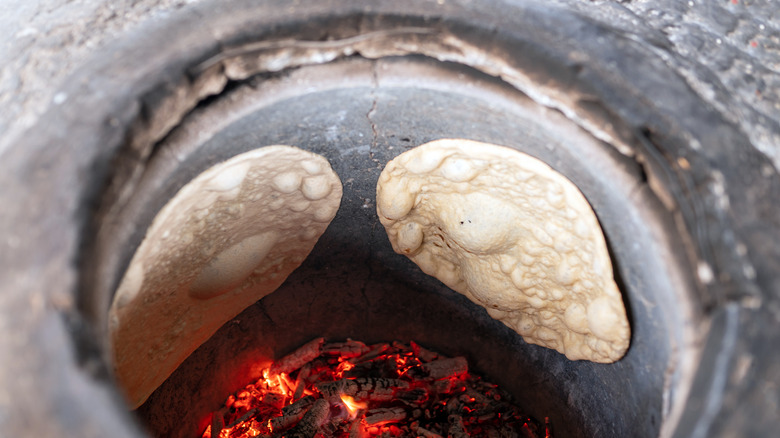The Real Difference Between Pita And Naan
Bread is a beloved commodity whether it be leavened like sourdough, boiled and steamed like bagels, fried flat, or made gluten-free, we are all obsessed. According to Grants Bakery, bread began about 30,000 years ago in Ancient Egypt, where it became our oldest form of food that relied on agriculture and did not require foraging or hunting. It was in the Fertile Crescent over hot fires that the cereal grains we used — and still use today — for bread were first cultivated. Now we have dozens of types of bread around the world, each with its own history, mythos, cultural influences, baking techniques, flavor profiles, flours blends, and purposes.
The history of flatbread is especially old. Now when we talk about flatbread, depending on where you grew up and the culture you were most exposed to, you could be imagining the tortilla, which was invented around 10,000 B.C. (via Alto Hartley). You could be thinking of frybread, which became popular in the Americas after the U.S. Government forced native people into reservations (via Native Partnership). Or even cong you bing laced with scallions recorded by Marco Polo (via 196 Flavors). But some of the two most popular but most commonly confused flatbreads are pita and naan bread.
What is Pita bread?
Unless you grew up in a house obsessed with pita, naan, or both, odds are, you'd be hard-pressed to spot the difference between these two flatbreads. But trust us, these two types of bread are not the same. Pita bread is probably what you're most familiar with if you eat a lot of Greek or Turkish food. According to Hummus Bowls, the flatbread originated in the Middle East, and there is documentation that shows it to be around 4,000 years old. The Greeks coined the flatbread "pita" (πίτα), and it can be cooked by baking, steaming, frying, grilling, and most traditionally on a hot stove top or hot stone.
The Spruce Eats describes the pita (or pitta) as a leavened flatbread. Yep, a leavened flatbread ... sounds like an oxymoron, right? But pita is made from yeast, water, and flour and traditionally baked on stone. The water in the dough evaporates, causing the characteristic pocket to form in the pita bread, which allows you to pull it open and stuff it full of delicious food. There are various styles of pita. Some are flatter and used as wraps, others are mixed with spices and herbs before cooking, but all are baked off on high heat to ensure the pocket forms. In Mediterranean cuisine, it is common to stuff pita with meat, vegetables, or falafels to make a wrap for Palestinian shawarma or Greek gyros (via Eatpitapita).
What is naan bread?
Like pita bread, naan is a circular flatbread, but the Greatist states that naan is softer in texture than pita and originated a little further southeast in India. The name "naan" originates from the Persian word "non" (a.k.a. bread). This is very much like the Greek word "pita," which directly translates to "flatbread." Naan is unique from pita in that it uses dairy products in its dough, including yogurt, milk, eggs, and sometimes butter or ghee, to create a softer baked product.
According to the Indian Express, naan is about 2,500 years old and uses yeast to create its characteristic bubbly appearance. To cook it, bakers will shape the dough and then slap it onto the walls of a clay oven called a tandoor. The bread puffs up in bubbles as it bakes. Seattle India Bistro explains that naan is essential to Indian cuisine because its mild taste balances out otherwise powerfully-flavored food. It is also used as an edible utensil to pull apart and eat, similar to Ethiopian injera bread. Naan can come in all kinds of flavors and is perfect for soaking up Kabocha curries and a variety of popular Indian dishes we know and love.


